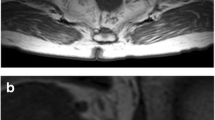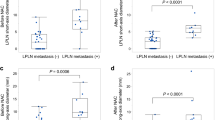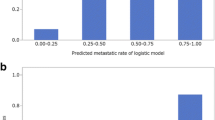Abstract
Purpose
To investigate the optimum cutoff for lymph node size to identify cases positive for perirectal lymph node (PRLN) and lateral lymph node (LPLN) metastasis of lower rectal cancer on magnetic resonance imaging (MRI).
Methods
The subjects were 449 patients who underwent preoperative MRI. Mesorectal excision was performed in all patients (combined with lateral pelvic lymph node [LN] dissection in 324) between 2004 and 2013 at 6 institutes. Cases were classified as cN positive and cN negative on the basis of the short axis of the largest LN being greater than or equal to a cutoff or less than a cutoff, respectively. PRLN and LPLN diagnoses using 5 and 10 mm cutoffs were compared with histologic diagnoses. Of the 449 patients, 55 received preoperative chemoradiotherapy. MRI was only performed after this therapy in all of these patients.
Results
For PRLNs, 5 and 10 mm cutoffs gave area under the curve (AUC) values of 0.6364 and 0.5794, respectively. The 5 mm cutoff gave a significantly higher AUC value (P = 0.0152), with an accuracy of 63.7 %, sensitivity of 72.6 %, and specificity of 54.7 %. For right LPLNs, the respective AUC values were 0.7418 and 0.6326 (P = 0.0034), and the variables (5 mm cutoff) were 77.6, 68.6, and 79.7 %. For left LPLNs, AUC values were 0.7593 and 0.6559, respectively (P = 0.0057), and the variables (5 mm cutoff) were 79.3, 70.8, and 81.0 %.
Conclusions
Identification of LN-positive cases on the basis of PRLN and LPLN sizes was superior at a short-axis 5 mm cutoff. Size-based diagnosis of LN metastasis is simple and useful, but further investigation is needed to clarify whether it is superior to diagnosis based on morphology, such as shape, border, and signal intensity.
Similar content being viewed by others
References
Torkzad MR, Påhlman L, Glimelius B. Magnetic resonance imaging (MRI) in rectal cancer: a comprehensive review. Insights Imaging. 2010;1:245–67.
Al-Sukhni E, Milot L, Fruitman M, et al. Diagnostic accuracy of MRI for assessment of T category, lymph node metastases, and circumferential resection margin involvement in patients with rectal cancer: a systematic review and meta-analysis. Ann Surg Oncol. 2012;19:2212–23.
Watanabe T, Itabashi M, Shimada Y, et al. Japanese Society for Cancer of the Colon and Rectum (JSCCR) guidelines 2010 for the treatment of colorectal cancer. Int J Clin Oncol. 2012;17:1–29.
Georgiou P, Tan E, Gouvas N, et al. Extended lymphadenectomy versus conventional surgery for rectal cancer: a meta-analysis. Lancet Oncol. 2009;10:1053–62.
Wang Z, Loh KY, Tan KY, Woo EC. The role of lateral lymph node dissection in the management of lower rectal cancer. Langenbecks Arch Surg. 2012;397:353–61.
Kim TH, Jeong SY, Choi DH, et al. Lateral lymph node metastasis is a major cause of locoregional recurrence in rectal cancer treated with preoperative chemoradiotherapy and curative resection. Ann Surg Oncol. 2008;15:729–37.
MERCURY Study Group; Shihab OC, Taylor F, Bees N, et al. Relevance of magnetic resonance imaging-detected pelvic sidewall lymph node involvement in rectal cancer. Br J Surg. 2011;98:1798–804.
Kim NK, Kim MJ, Yun SH, Sohn SK, Min JS. Comparative study of transrectal ultrasonography, pelvic computerized tomography, and magnetic resonance imaging in preoperative staging of rectal cancer. Dis Colon Rectum. 1999;42:770–5.
Kim NK, Kim MJ, Park JK, Park SI, Min JS. Preoperative staging of rectal cancer with mri: accuracy and clinical usefulness. Ann Surg Oncol. 2000;7:732–7.
Arii K, Takifuji K, Yokoyama S, et al. Preoperative evaluation of pelvic lateral lymph node of patients with lower rectal cancer: comparison study of MR imaging and CT in 53 patients. Langenbecks Arch Surg. 2006;391:449–54.
Matsuoka H, Nakamura A, Masaki T, et al. Optimal diagnostic criteria for lateral pelvic lymph node metastasis in rectal carcinoma. Anticancer Res. 2007;27:3529–33.
Min BS, Kim JS, Kim NK, et al. Extended lymph node dissection for rectal cancer with radiologically diagnosed extramesenteric lymph node metastasis. Ann Surg Oncol. 2009;16:3271–8.
Akasu T, Iinuma G, Takawa M, Yamamoto S, Muramatsu Y, Moriyama N. Accuracy of high-resolution magnetic resonance imaging in preoperative staging of rectal cancer. Ann Surg Oncol. 2009;16:2787–94.
Lim SB, Yu CS, Kim CW, et al. Clinical implication of additional selective lateral lymph node excision in patients with locally advanced rectal cancer who underwent preoperative chemoradiotherapy. Int J Colorectal Dis. 2013;28:1667–74.
Akiyoshi T, Ueno M, Matsueda K, et al. Selective lateral pelvic lymph node dissection in patients with advanced low rectal cancer treated with preoperative chemoradiotherapy based on pretreatment imaging. Ann Surg Oncol. 2014;21:189–96.
Edge SB, Byrd DR, Compton CC, Fritz AG, Greene FL, Trotti A. AJCC cancer staging manual. 7th ed. New York: Springer; 2010.
Brown G, Richards CJ, Bourne MW, et al. Morphologic predictors of lymph node status in rectal cancer with use of high-spatial-resolution MR imaging with histopathologic comparison. Radiology. 2003;227:371–7.
Beets-Tan RG, Beets GL. Local staging of rectal cancer: a review of imaging. J Magn Reson Imaging. 2011;33:1012–9.
Akobeng AK. Understanding diagnostic tests 3: receiver operating characteristic curves. Acta Paediatr. 2007;96:644–7.
Choi J, Oh SN, Yeo DM, et al. Computed tomography and magnetic resonance imaging evaluation of lymph node metastasis in early colorectal cancer. World J Gastroenterol. 2015;21:556–62.
Will O, Purkayastha S, Chan C, et al. Diagnostic precision of nanoparticle-enhanced MRI for lymph-node metastases: a meta-analysis. Lancet Oncol. 2006;7:52–60.
Acknowledgment
This work was supported by the JSCCR.
Disclosure
The authors declare no conflict of interest.
Author information
Authors and Affiliations
Corresponding author
Rights and permissions
About this article
Cite this article
Ogawa, S., Hida, Ji., Ike, H. et al. Selection of Lymph Node–Positive Cases Based on Perirectal and Lateral Pelvic Lymph Nodes Using Magnetic Resonance Imaging: Study of the Japanese Society for Cancer of the Colon and Rectum. Ann Surg Oncol 23, 1187–1194 (2016). https://doi.org/10.1245/s10434-015-5021-2
Received:
Published:
Issue Date:
DOI: https://doi.org/10.1245/s10434-015-5021-2




